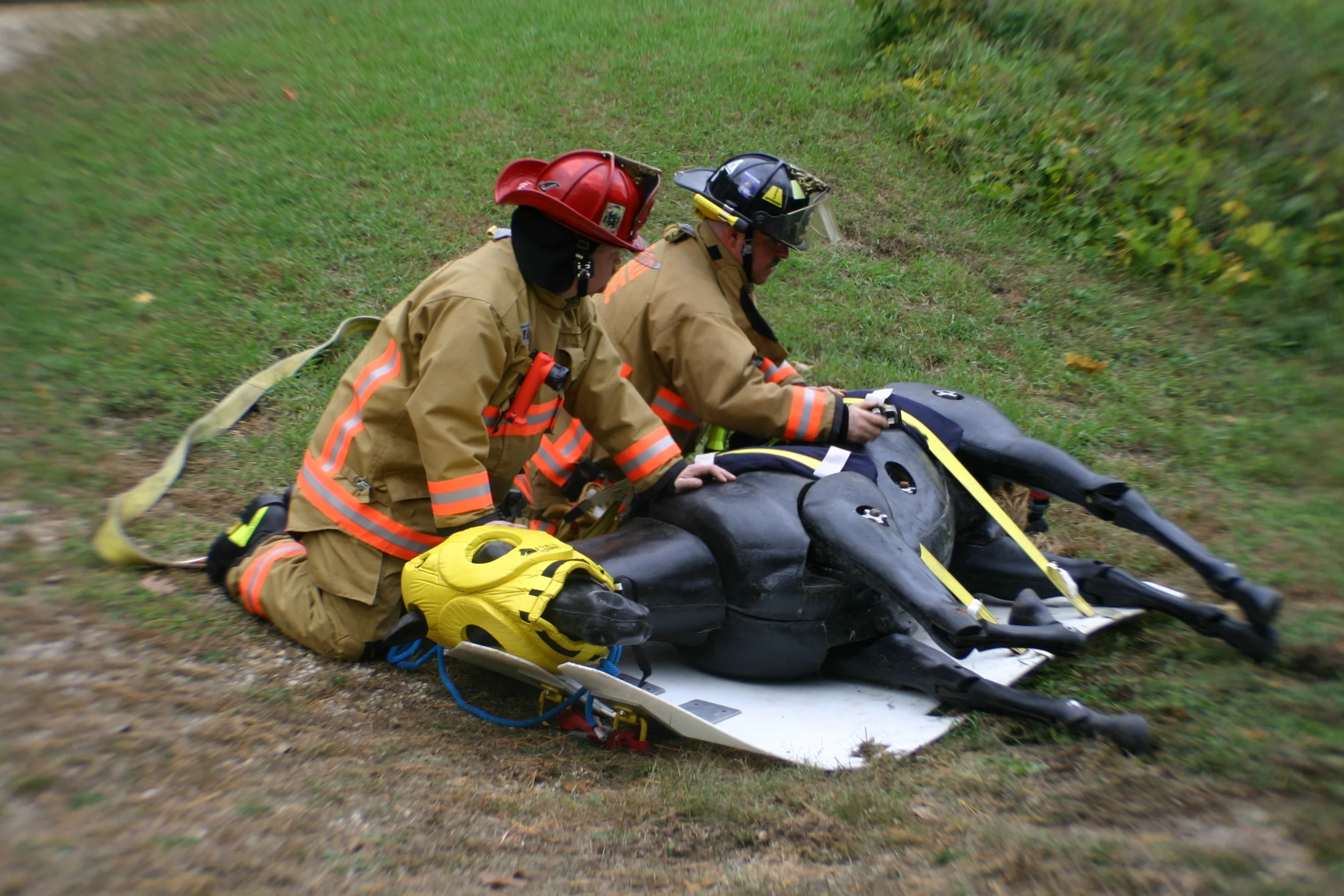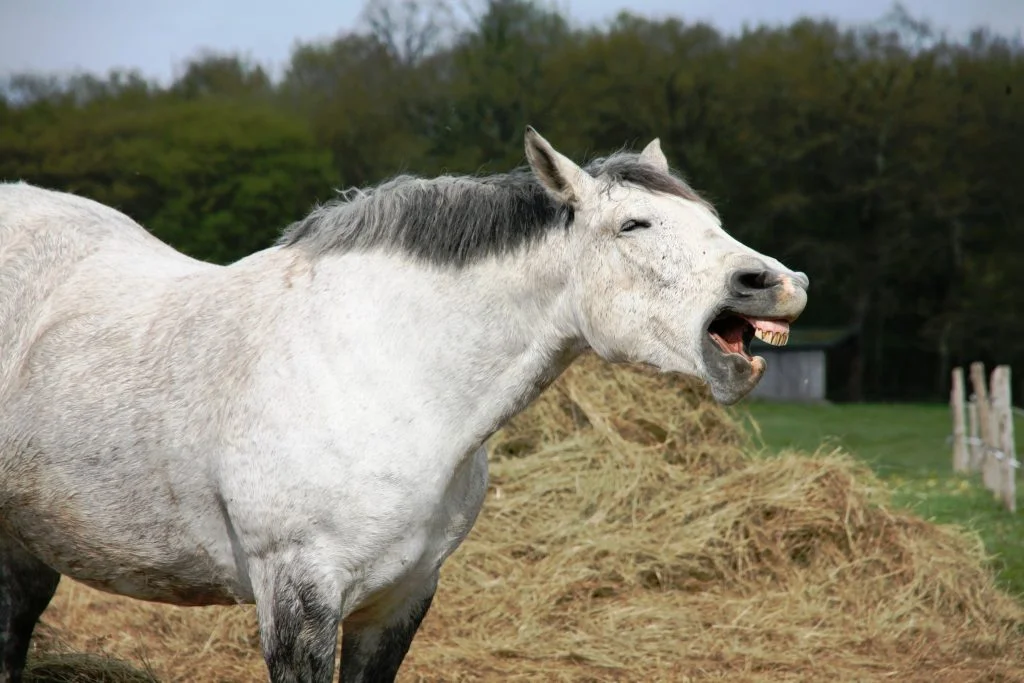In this episode, Dr. Lisa Nesson DVM demonstrates how to bandage a full front leg on a horse.
7 Equine Emergencies and How to Treat Them
Here are seven common equine injuries and conditions, and the best ways to react to them. Remember – the first step should almost ALWAYS be to call your veterinarian, at least for a conversation.
Bleeding and Lacerations
These injuries should be immediately treated in much the same way that you would treat a child’s laceration.
This V shaped wound won't need a drain to facilitate healing.
DO stop the bleeding by applying direct pressure or pressure with a bandage.
DON’T remove the bandage to peek at the injury! It’s tempting to look under the bandage, but you’ll be backtracking on treatment. By applying pressure to the wound, you’re helping it begin clotting. If you remove that pressure, it could halt all clotting and begin bleeding again.
DON’T apply a tourniquet unless specifically told otherwise by your veterinarian. If you’re applying a tourniquet correctly, you’re likely about to start causing pressure damage to nerves and arteries nearby.
DO run cold water over it. Hoses work well for this. Don’t put your thumb over the hose head to increase pressure – just let the cool water stream down over the laceration.
DON’T apply any ointments on the wound. Once you apply something to the wound, you have decided how we’re going to treat it. We’re usually unable to use sutures when you’ve used any ointments. Not to mention, it’s a lot more difficult to see the injury when it’s covered in bright bloop goop. So, just avoid the products. That includes Blue-Kote, Red-Kote, Furazone, Hydrogen Peroxide, Scarlet Oil, and any other commercially or home-made product. Just hold your horses, your veterinarian will be there soon.
When you call your veterinarian, have the following information available:
What’s the location of the laceration?
How deep is it? Is bone visible?
Is there any lameness associated with it so far?
Is your horse contained in a safe location?
Colic
Rolling can be a mundane part of a horse's day, or a sign of a serious GI issue.
Colic isn’t a specific condition – it’s actually a broad term referencing any gastrointestinal pain. We use the word in the same way pediatricians and parents use the term for a colicky baby. There are a few main types of colic, all of varying severity.
Gas bubbles – This isn’t usually a big deal. The intestine quickly distends, or expands, and becomes painful, but a horse can walk it off a resolve it quickly. These are the colics which are likely going to resolve themselves.
Impaction – This is similar to a gas bubble, but caused by a food blockage. The intestine can normally treat itself while we make the horse comfortable with pain medication. Your veterinarian may help the process by completing a rectal exam and pulling some excess manure out to promote movement.
Twist – Arguably the most serious type of colic, a twist means that the large intestine has twisted around itself, cutting off blood supply, and trapping gas and food material inside of the intestine. A tricky component of a twist is that the intestine won’t distend for a while, so your horse may not show any indications of pain.
Bowel rupture – A ruptured stomach is normally a secondary issue. Your horse was likely suffering from an enterolith, gas bubbles, or impaction which was unresolved. The pain likely became more serious, and then mysteriously disappeared. Sudden relief from pain indicates that the stomach may have ruptured. Since the intestine is no longer distended, which is what is actually causing the pain, your horse is no longer in pain. At this point, your horse should be at an equine hospital and prepared for surgery. Any delay in surgical treatment increases the risk of fatality.
So, how do you recognize and treat colic? Your horse may not have passed any manure in a while. He may be attempting to roll, kicking at his stomach, or looking back at his stomach with anxiety.
The first thing you should do is contain your horse – he may attempt to run away from the pain. Close all of the gaits prior to continuing to work with him. Next, carefully assess the horse – see if he’s interested in eating anything, if he has passed any manure lately, and how violently he is moving around. If your horse is attempting to roll or thrash around, safely attempt to get him standing up and slowly moving around. Keeping your horse moving can help the intestinal blockage, but violently thrashing can make the problem worse and result in a twist. If he wants to lie down quietly, that’s ok. Next, contact your veterinarian. You may treat your horse with pain medication only after speaking to your veterinarian, and if you’re confident in how to use the medication. Finally, think about your truck and trailer options should your horse need surgery, and begin contacting anyone whose help you will need. Your veterinarian will determine the type of colic and how to treat when she arrives, but it’s best to be as prepared as possible.
Foaling
When a mare is foaling, time is critical. If your foal is not out within twenty minutes of the water breaking, or if you’re not seeing progress at all, you need to call your veterinarian immediately. This is one of the only equine emergencies where a veterinarian’s presence will most certainly affect whether your mare and foal live or die. Call your veterinarian immediately if you’re not seeing progress, or if you see that the foal is presenting with something other than her front feet first. In 99% of foalings, everything goes smoothly. For the 1% of cases where something goes wrong, it goes extremely wrong.
Eye Injuries
Compare the bright and clear eye on the left with the obviously injured eye on the right.
Eye injuries – lacerations or blunt trauma – need to be seen immediately. No matter how far gone the eye or eyelid seems, it’s always worth it to attempt to fix the injury and preserve your horse’s vision. Contact your veterinarian as soon as possible if you notice an obvious a severe injury.
On the flip side of the coin, it’s sometimes hard to recognize eye injuries that don’t include bleeding, torn skin, or swelling. When a horse is experiencing pain or irritation in his eyes, he’ll usually be squinting or tearing up, may have some cloudiness in the actual eye, and may even by rubbing his eyes on hard surfaces. Often times, you can recognize eye irritation by the position of the eyelashes. A healthy horse has eyelashes that are almost parallel to the ground – they’ll be erect and clear of fluid. A damaged eye will eyelashes that are tilted down slightly.
Respiratory Distress vs. Choke
There are subtle differences between respiratory distress and choke in horses. Identifying these differences lead to significant differences in how to treat your horse.
Respiratory Distress:
Your horse will have rapid, shallow breathing, and will likely appear very stressed. Look for an anxious expression and exaggerated respirations, visible from the flanks and the chest. To treat, you’ll need to keep your horse quiet and attempt to calm her, and remove any allergens. With respiratory distress, timeliness is key with veterinary assistance. A tracheotomy may be necessary to help your horse continue breathing.
Equine Choke:
Choke is just what it sounds like – there’s some blockage which is preventing your horse from swallowing. However, your horse can still breathe. A common cause is pelleted feed – when your horse eats that feed very rapidly, the feed can combine and create a blockage in the esophagus. Similarly, if your horse hasn’t had appropriate dental care recently and struggles to chew his food, a blockage may develop.
Nasal discharge is a common sign of choke – the discharge will often be feed colored, which can give you a very big clue as to the problem. Your horse is likely disinterested in feed at this point. And, as with respiratory distress and all other equine emergencies, he will likely appear stressed. Remove your horse’s feed so that he doesn’t make the problem worse, and attempt to keep him calm. You’ve got a little more time with choke than respiratory distress, so it’s ok to wait and see if your horse is able to resolve the blockage himself.
Downed Horse
Assisting a downed horse is dangerous and highly technical. To that end, we won’t be covering all of the ins and outs of that process here. Instead, we’ll host a technical rescue client education seminar with hands on work, and do a follow-up post with the steps, video, and pictures. In the meantime, here’s some basic information and important tips.
DO ensure your horse has good footing. If he’s on ice or mud, which can contribute to a horse’s struggle to stand, improve the footing by putting cat litter, carpet, bedding, or even sand under hit feet.
DO warm your horse if it’s winter. Particularly if they’ve been down for a while in the winter, a cold horse’s muscles will be tense and stiff, limiting their ability to push themselves up. Additionally, if your horse has been down for a while, you’ll need to start worrying about hypothermia. And don’t just stick with a regular quilt or horse blanket – pull out an emergency SPACE blanket, which you can buy from Walmart, Amazon, outdoors stores, etc., for less than $5.00. Put the SPACE blanket immediately on your horse, and other blankets on top of that. The increased warmth may give your horse the impetus to stand that he needs.
DON’T harass your horse to get up. Let him rest while help arrives. Depending on how long he’s been trying to stand, he may only have one last attempt in him. Let him rest prior to your final push.
DO remember the number one rule when is comes to helping a “Downed” animal – no one gets hurt.
Have questions regarding equine emergency rescue? Contact the office, we are here to help!
Case Study: Shockwave Therapy
Extracorporeal Shock Wave Technology (ESWT) uses a specialized machine to provide a high-energy, focused pressure wave to a specific location on the body. This results in several biological changes in the tissues being treated. It stimulates the release of proteins associated with the healing process, as well as regulating inflammation and providing analgesia (pain relief).
What To Do About Colic
Slip Sliding Away
The Equine Eye
Stocking Your Equine First Aid Kit
Helping a Downed Horse
In winter terrain and weather, a horse that’s down on ice is in a life threatening situation. The horse may be suffering from an injury from falling on the ice, or have hypothermia from laying in the snow/ice for a long period of time. This is often from an inability to stand due to poor traction and muscle weakness from the cold.

































